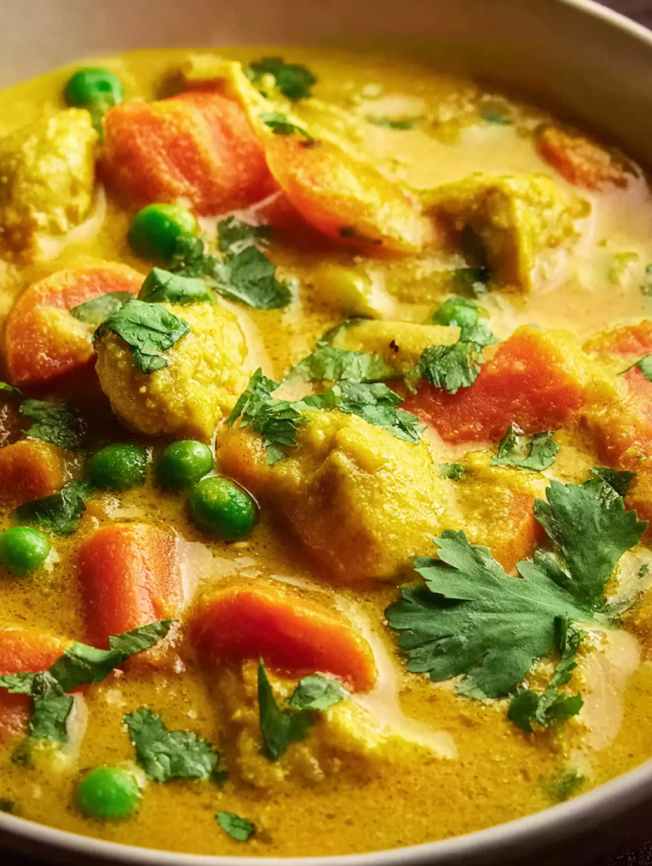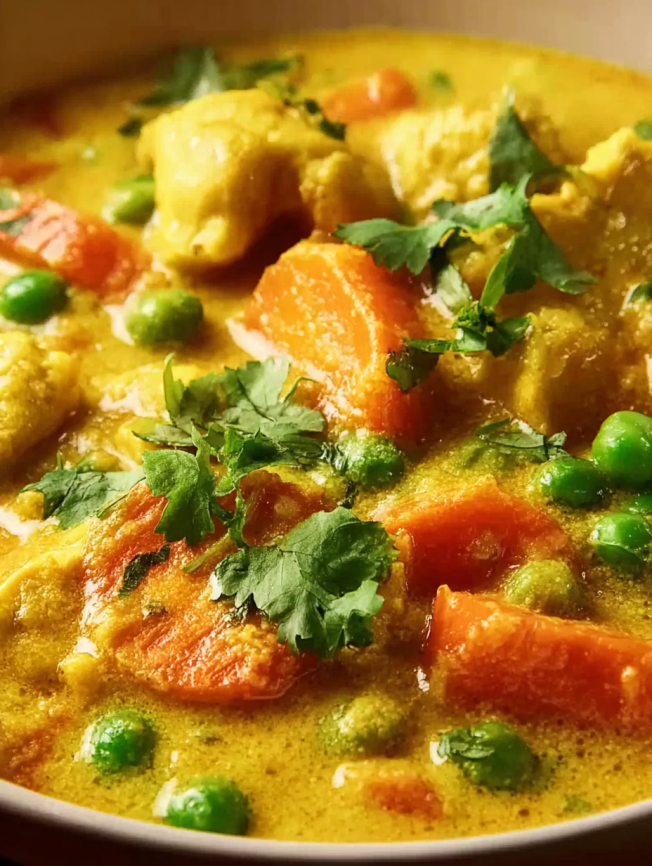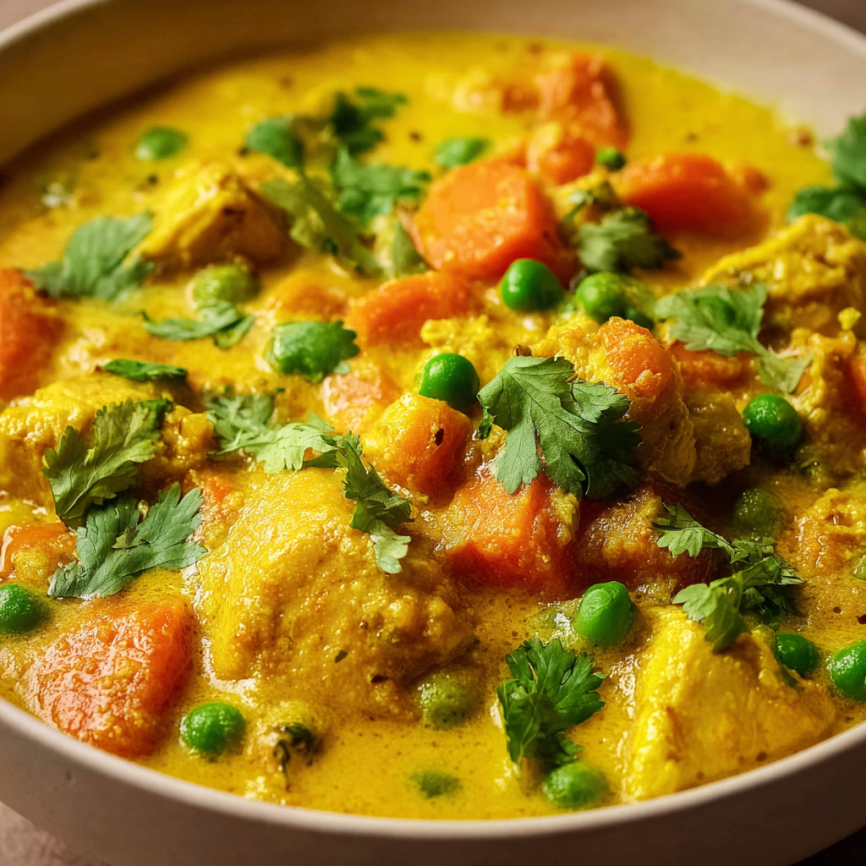Growing up, the scent of toasted spices wafting from my neighbor’s kitchen always transported me to distant lands filled with vibrant markets and exotic flavors. Years later, when I first attempted to recreate that magical aroma, I discovered the beautiful world of Indian korma. This creamy vegetable korma has since become my go-to comfort dish—a warm embrace in a bowl that never fails to satisfy both body and soul.
Why You’ll Fall in Love with This Recipe
Perfect Balance of Flavors
Unlike many Indian dishes that can overwhelm newcomers with intense heat, this korma strikes the perfect balance between aromatic spices and creamy richness. Moreover, the combination of garam masala, turmeric, and cumin creates layers of complexity without overpowering the natural sweetness of the vegetables.
Nutritional Powerhouse
Each serving delivers a rainbow of nutrients from cauliflower’s vitamin C, carrots’ beta-carotene, and green beans’ fiber. Additionally, the coconut milk provides healthy fats while the variety of vegetables ensures you’re getting a well-rounded meal that nourishes from within.
Versatility at Its Best
Whether you’re hosting a dinner party or preparing a weeknight family meal, this korma adapts beautifully to any occasion. Furthermore, it’s naturally vegetarian and can easily be made vegan by substituting the heavy cream with additional coconut milk.
Essential Ingredients
The Spice Foundation
- 2 tablespoons vegetable oil
- 1 medium yellow onion, finely chopped
- 3 cloves garlic, minced
- 1 tablespoon fresh ginger, grated
- 1 tablespoon garam masala
- 1 teaspoon turmeric
- 1 teaspoon ground cumin
- 1/2 teaspoon ground coriander
- 1/2 teaspoon cayenne pepper (optional)
The Creamy Base
- 1/2 cup tomato sauce
- 1 cup coconut milk (full-fat)
- 1/2 cup heavy cream
Fresh Vegetables
- 2 cups chopped cauliflower
- 1 cup diced carrots
- 1 cup green beans, trimmed and halved
- 1 cup frozen peas
- Salt and pepper to taste
- 1/4 cup chopped cilantro for garnish
Perfect Serving Companions
- Cooked basmati rice
- Warm naan bread
- Quinoa for a protein boost
- Cauliflower rice for low-carb option
Step-by-Step Cooking Instructions
Building the Flavor Base
Begin by heating the vegetable oil in a large skillet over medium heat. Once the oil shimmers, add the finely chopped onion and sauté for approximately 5 minutes until it becomes translucent and fragrant. Next, incorporate the minced garlic and grated ginger, stirring constantly for about 1 minute to prevent burning while releasing their aromatic oils.
Blooming the Spices
Add the garam masala, turmeric, cumin, coriander, and optional cayenne pepper to the pan. Stir the mixture continuously for 30-60 seconds until the spices become fragrant and slightly darkened. This crucial step, known as “blooming,” intensifies the flavors and prevents the spices from tasting raw in the finished dish.
Creating the Sauce
Pour in the tomato sauce and cook for 2 minutes, allowing it to reduce slightly and blend with the aromatic spice mixture. Then, slowly add the coconut milk and heavy cream, whisking gently to create a smooth, unified base. Bring the mixture to a gentle simmer, being careful not to let it boil rapidly as this could cause the cream to curdle.
Adding the Vegetables
Carefully fold in the cauliflower, carrots, and green beans, ensuring each piece gets coated with the creamy sauce. Cover the skillet and allow the vegetables to cook for 10-12 minutes, or until they’re tender but still retain a slight bite. During this time, stir occasionally to prevent sticking and ensure even cooking.
Final Touches
Stir in the frozen peas and continue cooking for an additional 2-3 minutes until they’re heated through and bright green. Season the korma with salt and pepper to taste, adjusting the flavors as needed. Finally, remove from heat and garnish with freshly chopped cilantro for a burst of color and freshness.

Serving Suggestions
Traditional Pairings
Serve your korma over fluffy basmati rice, which acts like a sponge to absorb the incredible sauce. Alternatively, warm naan bread provides the perfect vehicle for scooping up every last drop of the creamy goodness.
Modern Twists
For a healthier approach, try serving over quinoa or cauliflower rice. Additionally, roasted sweet potato wedges make an unexpected but delightful accompaniment that complements the korma’s creamy richness.
Complete Meal Ideas
Transform this dish into a feast by adding cucumber raita, pickled onions, or a simple salad of mixed greens with lemon vinaigrette. These fresh elements provide a cooling contrast to the warm spices.
Recipe Variations to Explore
Protein Additions
While this recipe celebrates vegetables, you can easily incorporate protein by adding cubed paneer, chickpeas, or tender pieces of chicken during the vegetable cooking stage. These additions transform the korma into an even more substantial meal.
Vegetable Swaps
Feel free to customize the vegetables based on seasonal availability or personal preferences. Bell peppers, zucchini, sweet potatoes, or spinach all work beautifully in this versatile recipe. Just adjust cooking times accordingly to ensure everything reaches the perfect tenderness.
Spice Level Adjustments
For those who prefer more heat, increase the cayenne pepper or add a finely chopped jalapeño with the garlic and ginger. Conversely, omit the cayenne entirely for a completely mild version that’s perfect for sensitive palates.
Make-Ahead Tips
Advance Preparation
This korma actually improves in flavor when made a day ahead, allowing the spices to meld and deepen. Simply prepare the dish as directed, then refrigerate for up to 3 days. Reheat gently on the stovetop, adding a splash of coconut milk if needed to restore the creamy consistency.
Freezing Guidelines
The korma freezes beautifully for up to 3 months when stored in airtight containers. However, note that the texture of some vegetables may change slightly upon thawing. Thaw overnight in the refrigerator before reheating slowly on the stovetop.
Batch Cooking Benefits
Consider doubling the recipe when preparing, as the cooking time remains virtually the same while providing you with multiple meals. This strategy works particularly well for busy weeknights when you need a quick, satisfying dinner option.
Important Notes
Coconut Milk Selection: Always use full-fat coconut milk for the richest, creamiest results. Light coconut milk will work but won’t provide the same luxurious mouthfeel that makes this korma special.
Spice Freshness: For the most vibrant flavors, use freshly ground spices when possible. Whole spices that you grind yourself will always provide more intense flavor than pre-ground alternatives that may have lost their potency.
Cooking Temperature: Maintain a gentle simmer throughout the cooking process. High heat can cause the cream to separate and the vegetables to become mushy rather than tender.

Frequently Asked Questions
Can I make this recipe vegan?
Absolutely! Simply substitute the heavy cream with an additional 1/2 cup of coconut milk or use cashew cream for an equally rich result. The flavor profile remains deliciously intact while accommodating vegan dietary needs.
What if I don’t have garam masala?
While garam masala provides the signature flavor, you can create a substitute by combining equal parts ground cinnamon, cardamom, and cloves with a pinch of black pepper. Alternatively, curry powder works as a different but equally tasty substitution.
How do I prevent the vegetables from becoming mushy?
The key lies in adding vegetables according to their cooking times and maintaining proper heat control. Start with harder vegetables like carrots and cauliflower, then add quicker-cooking items like peas at the end. Keep the heat at a gentle simmer rather than a rolling boil.
Can I use frozen vegetables?
Fresh vegetables provide the best texture and flavor, but frozen alternatives work in a pinch. Just remember that frozen vegetables typically cook faster, so reduce the cooking time accordingly and add them later in the process to prevent overcooking.
How spicy is this dish?
This korma is considered mild to medium in terms of heat level. The warming spices provide depth and complexity without overwhelming heat, making it accessible to most palates. The optional cayenne pepper allows you to adjust the spice level to your preference.
What’s the best way to store leftovers?
Store leftover korma in airtight containers in the refrigerator for up to 4 days. The flavors actually develop and improve during storage, making leftovers often taste even better than the original meal. Reheat gently to preserve the creamy texture.
Prep Time: 15 minutes | Cooking Time: 25 minutes | Total Time: 40 minutes Calories: 310 per serving | Servings: 4

